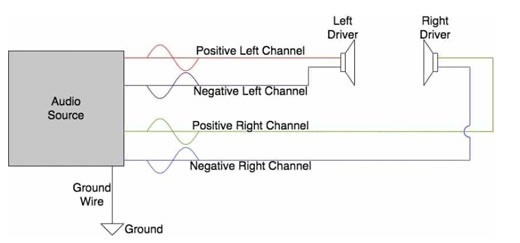- AccurateRip
- Acoustid
- AES/EBU
- AirPlay
- Amplifier
- aptX
- Audio file formats
- ASRC
- AVB
- Bit perfect jitter
- Bits: 16 or 24
- Bit perfect playback
- Bitrate
- Bluetooth
- Burn-in
- BWF
- Cables
- CDtext
- Chromecast
- Clipping
- Clock
- Codec
- Compression
- CRC
- Crossover
- Cue sheet
- DAC
- Damping
- DASH
- Digital
- Digital Room Correction
- Dither
- DLNA
- Drivers
- DoP
- DSP
- EBU R128 (loudness)
- FFT
- FireWire
- Freedb
- Gapless playback
- Generation loss
- HDMI
- Headphone listening
- Hearing
- Hires recording
- Homeplug
- I2S
- ID3
- Inter sample peak
- LDAC
- Linearity (DAC)
- Memory playback
- Music Server
- OCF
- OFC
- PCM
- Perception
- RAID
- ReplayGain
- Ripping
- RFI
- RIAA
- Router
- Sampling, up and over
- Sample Rate Conversion
- Speakers
- S/PDIF
- Storage
- Sync
- Tagging
- Toslink
- Transcoding
- UAA
- Units
- UPnP
- USB
- VST
- WiFi
- WiSA
Analog
Single ended
Most consumer gear has unbalanced connections. It needs 2 wires. Most of the time this is done using a coax cable. The signal is carried by the central wire and the shield is used as ground. The shield also prevents against IME and RFI. However, any stray signal picked up by the signal wire will be faithfully delivered at the receiver.

A very popular single ended connection is the RCA cable.
Instruments are often connected using a TS jack (Tip Sleeve)
Balanced
Pro-gear uses balanced connections. This requires 3 wires. One for the signal (hot), one for the inverted signal (cold) and a ground. Most of the time the cable as 2 wires inside a shield used as ground.
Again this shield protects to some extend against EMI/RFI.
Most of the time the gear itself is single ended, the balanced signal is created using a balun.
When external noise hits the 2 signal wires, both will be likewise affected as they are close together.
At the receiver the polarity of the inverted signal is flipped again. As the noise of the flipped signal has the reverse polarity, summing hot and (flipped) cold will remove all common noise.

Popular connectors are the XLR and the TRS jack.
(Un)Balanced
You can also connect headphones balanced.
A lot of amps do have a balanced headphone out.
You also need a balanced cable.
This has nothing to do with a balanced connection as described above.
It is a 4 wire connection, L+/L- and R+/R-.
Nothing "balanced" about this symmetrical connection but as L and R no longer have a common ground, it allow for amplifier topologies with a floating ground like indeed a balanced amp. That is why this double single ended connection is called "balanced" in the headphone world.
The choice to call this type of connection balanced is a very unlucky one and a permanent source of confusion.

Bit more detail in the headphone section
Balanced to Single Ended

Single ended to balanced

Extensive treatment of these type of conversions by Rane.
What's the Difference Between Balanced and Unbalanced? - Avion Blog
Sound System Interconnection - Rane Technical Staff RaneNote 110 (1985)

